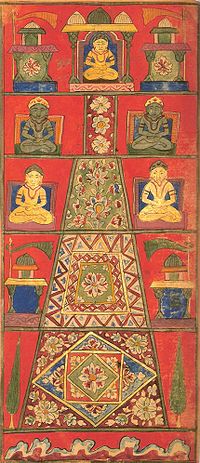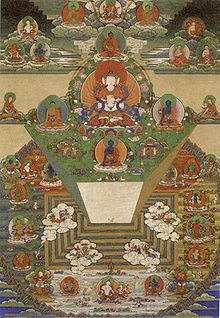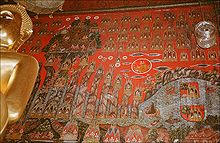- Mount Meru
-
For other uses, see Mount Meru (disambiguation).
 Painting of Mount Meru as per Jain cosmology from Jain text Samghayanarayana loose-leaf manuscript
Painting of Mount Meru as per Jain cosmology from Jain text Samghayanarayana loose-leaf manuscript
 Bhutanese thanka of Mount Meru and the Buddhist Universe, 19th century, Trongsa Dzong, Trongsa, Bhutan
Bhutanese thanka of Mount Meru and the Buddhist Universe, 19th century, Trongsa Dzong, Trongsa, Bhutan
Mount Meru (Sanskrit: मेरु) (also called Sumeru i.e. the "Excellent Meru") is a sacred mountain in Hindu and Buddhist cosmology as well as in Jain cosmology, and is considered to be the center of all the physical, metaphysical and spiritual universes. It is also the abode of Lord Brahma and the Demi-Gods (Devas).
The mountain is said to be 84,000 Yojanas high (which is around 1,082,000 km (672,000 mi), or 85 times the Earths's diameter). Many famous Hindu and Jain temples have been built as symbolic representations of this mountain. The highest point (the finial bud) on the pyatthat, a Burmese-style multi-tiered roof, represents Mount Meru.
For the equivalent central mountain in Buddhist cosmology, see Sumeru.
Contents
Location
Mount Meru of Hindu traditions has clearly mythical aspects, being described as 84,000 Yojanas high, and having the Sun along with all its planets and stars in the Solar System revolve around it as one unit.
Geographical
The dimensions attributed to Mount Meru, all the references to it being as a part of the Cosmic Ocean, along with several statements like that the Sun along with all the planets (including Earth itself) circumbulate the mountain, make determining its location most difficult, according to most scholars.[1][2] However, a small handful number of western scholars have tried quite hard to identify Mount Meru or Sumeru with the Pamirs, north-east of Kashmir.[3]
The Suryasiddhanta mentions that Mt Meru lies in 'the middle of the Earth' ("bhugola-madhya") in the land of the Jambunada (Jambudvipa). Narpatijayacharyā, a 9th century text, based on mostly unpublished texts of Yāmala Tantra, mentions "Sumeruḥ Prithvī-madhye shrūyate drishyate na tu" ('Su-meru is heard to be in the middle of the Earth, but is not seen there').[4] Vārāha Mihira, in his Panch-siddhāntikā, claims Mt Meru to be at the North Pole (though no mountain exists there as well). Suryasiddhānta, however, mentions a Mt Meru in the middle of Earth, besides a Sumeru and a Kumeru at both the Poles.
There exist several versions of Cosmology in existing Hindu texts. In one of them, cosmologically, the Meru mountain was also described as being surrounded by Mandrachal Mountain to the east, Supasarva Mountain to the west, Kumuda Mountain to the north and Kailash to the south.[5]
Height
One Yojana can be taken to mean about 11.5 km (9 mi) though its magnitude seems to differ over time periods. E.g. the Earth's circumference is 3,200 Yojanas according to Vārāhamihira and slightly less so in the Āryabhatiya, but is given to be 5,026.5 Yojanas in the Suryasiddhānta. The Matsya Purana and the Bhāgvata Purāna along with some other Hindu texts consistently give the exorbitant dimension of 84,000 Yojanas to Mount Meru which translates into 672,000 miles or 1.082 million kilometers.
Puranic legends
Mount Meru finds mention innumerable times in Hindu lore. Some of the better-known legends are recounted here. Legends say that Mount Meru and the wind god Vayu were good friends. However, the sage Narada approached Vayu and incited him to humble the mountain. Vayu blew with full force for one full year, but Meru was shielded by Garuda with his wings (he was flying high). However, after a year Garuda took respite for some time. Thus the apex of the mountain was broken and it fell into the sea and created the island of Lanka.
Mount Meru was said to be the residence of King Padamja Brahma in antiquity.[6]
The Puranas and Hindu epics, often state that Surya, i.e. the sun-God, along with all its planets and stars together as one unit, circumambulate Mount Meru every day.
Javanese legends
This mythical mountain of gods was mentioned in Tantu Pagelaran, an Old Javanese manuscript written in Kawi language from 15th century Majapahit period. The manuscript is describing the mythical origin of Java island, and the legend of moving some parts of mount Meru to Java. The manuscript explained that Batara Guru (Shiva) has ordered the god Brahma and Vishnu to fill the Java island with human beings. However at that time Java island was floating freely on the ocean, ever tumbling and always shaking. To make the island still, the gods decided to nail the island upon the earth by moving the part of Mahameru in Jambudvipa (India) and attaching it upon Java.[7] The resulting mountain is Mount Semeru, the tallest mountain of Java.
Notes
- ^ Sachau, Edward C. (2001). Alberuni's India. Psychology Press. p. 271. ISBN 9780415244978. http://books.google.co.in/books?id=a91-t4uw8A4C&pg=PA271&lpg=PA271&dq=Meru+sun+planets+revolve#v=onepage&q=Meru%20sun%20planets%20revolve&f=false.
- ^ http://www.sacred-texts.com/hin/db/bk08ch15.htm
- ^ The Geopolitics of South Asia: From Early Empires to the Nuclear Age, 2003, p 16, Graham P. Chapman - Social Science; The Pamirs and the Source of the Oxus, p 15, George Nathaniel Curzon; The Hindu World: An Encyclopedic Survey of Hinduism, 1968, p 184, Benjamin Walker - Hinduism; Ancient Indian Tradition & Mythology: Purāṇas in Translation, 1969, p 56, Jagdish Lal Shastri, Arnold Kunst, G. P. Bhatt, Ganesh Vasudeo Tagare - Oriental literature; Journal of the K.R. Cama Oriental Institute, 1928, p 38, K.R. Cama Oriental Institute - Iranian philology; The Occult in Russian and Soviet Culture, 1997, p 175, Bernice Glatzer Rosenthal - History; Geographical Concepts in Ancient India, 1967, p 50, Bechan Dube - India; Geographical Data in the Early Purāṇas: A Critical Study, 1972, p 2, Dr M. R. Singh - India; Studies in the Proto-history of India, 1971, p 17, Dr Dvārakā Prasāda Miśra - India.
- ^ cf. second verse of Koorma-chakra in the book Narpatijayacharyā
- ^ J.P. Mittal, History of Ancient India: From 7300 BC to 4250 BC, page 3
- ^ J.P. Mittal, History of Ancient India: From 7300 BC to 4250 BC, page 3
- ^ Soekmono, Dr R. (1973). Pengantar Sejarah Kebudayaan Indonesia 2. Yogyakarta, Indonesia: Penerbit Kanisius. pp. 119. ISBN 979-413-290-X.
Sources
Further information: Jyotiṣa bibliography- Narpatijayacharyā, commentary by Ganeshdatta Pathak, Cublished by Chowkhambha Sanskrit Sansthana, Varanasi, India, PIN-221001
See also
External links
- Description of Mount Meru in the Devi-bhagavata-purana 12
- Painting of Mount Meru found in Buddhist cave sanctuary in Chinese Turkestan
- Mount Meru in Encyclopedia of Buddhist Iconography 12
Hindu deities and texts Gods 
Goddesses Texts Categories:- Locations in Hindu mythology
- Mythological mountains
- Jain cosmology
- Ancient Indian mountains
Wikimedia Foundation. 2010.

